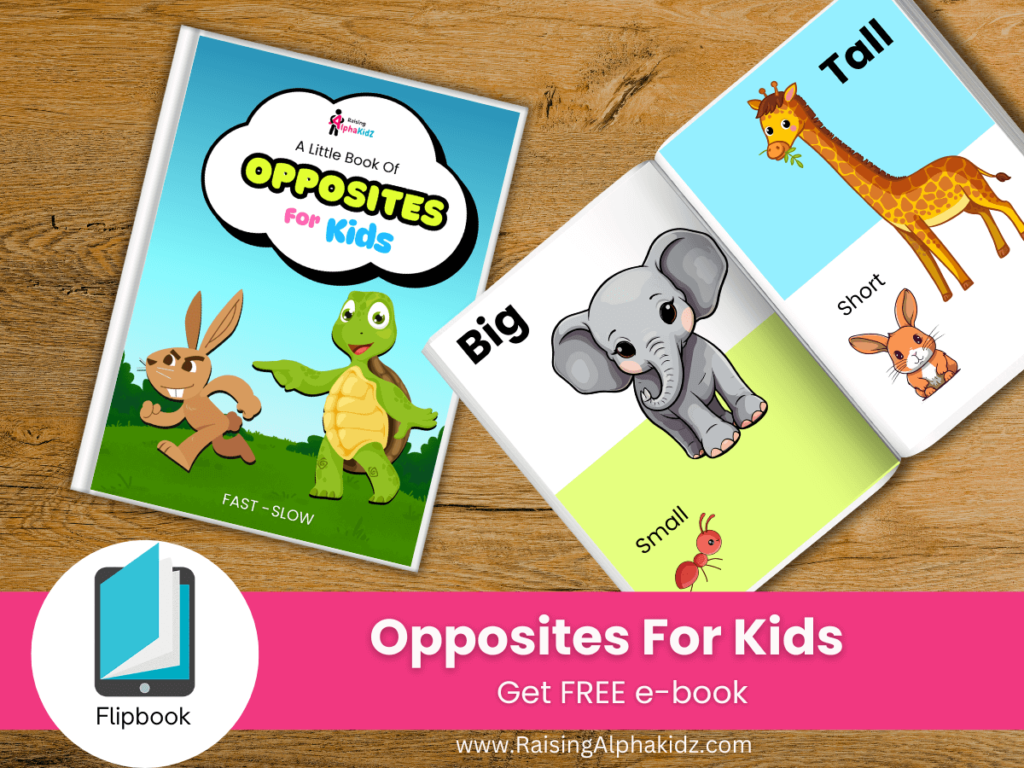A Little Book Of Opposites For Kids – Download Free Ebook
As parents and educators, we’re always looking for creative ways to help children expand their vocabulary, improve their communication skills, and understand the world around them. One of the most fundamental concepts to teach young learners is the idea of opposites. Opposites are not only essential for language development but also help kids make sense of relationships between objects, emotions, and actions.
But how do you teach opposites in a way that sticks? In this post, we’ll explore brain-friendly methods to teach opposite words to kids, share free resources like our interactive flipbook eBook, and reveal why mastering antonyms is a game-changer for young learners. Let’s dive in!
Why Opposites Matter for Kids
- Opposites (or antonyms) help kids make sense of the world by contrasting ideas.
- They boost language development, critical thinking, and problem-solving skills.
- For example, understanding “hot” vs. “cold” isn’t just vocabulary—it’s safety!
How the Brain Learns Opposites Best
The human brain thrives on multisensory learning. Combine visuals, movement, and play to make opposites unforgettable. Here’s how:
1. Pair Words with Visuals
Use flashcards, pictures, or videos. Our free eBook, “A Little Book of Opposites for Kids”, does this perfectly! It’s a colorful flipbook with 20 common opposites like big/small and day/night, designed to captivate young minds.
2. Play Opposite Games
- Matching Cards: Kids pair antonyms like fast/slow.
- Opposite Scavenger Hunt: “Find something light and something heavy!”
- Simon Says: “Jump high! Now crouch low.”
3. Sing & Move
Songs like “Open Shut Them” or acting out words (stand/sit, laugh/cry) engage the body and brain.
4. Storytime Twists
Read books highlighting opposites, then ask, “What’s the opposite of giant in this story?”
Basic Opposite Words for kids
| Word | Opposite |
|---|---|
| Big | Small |
| Tall | Short |
| Heavy | Light |
| Fast | Slow |
| Full | Empty |
| Hot | Cold |
| Open | Closed |
| Clean | Dirty |
| Black | White |
| Happy | Sad |
| Sleep | Awake |
| Strong | Weak |
| Wet | Dry |
| Soft | Hard |
| More | Less |
| Old | Young |
| Inside | Outside |
| Thick | Thin |
| Above | Below |
| Day | Night |
Download Free Opposites eBook
Struggling to find engaging resources? Our free eBook, “A Little Book of Opposites for Kids”, is a flipbook packed with 20 vibrant pairs of all common opposites that kids found all around them. It’s perfect for visual learners and busy parents! Download it below.
Copyright Notice
This eBook is for personal use only. You are permitted to download, view, and print a copy for your own non-commercial purposes. All rights reserved.
Checkout Other Useful eBooks For kids
Advanced Opposite Words to Level Up
1. Family Relationship Opposites
| Word | Opposite |
|---|---|
| Father | Mother |
| Brother | Sister |
| Boy | Girl |
| Aunt | Uncle |
| Grandfather | Grandmother |
Tip: Use family photos or role-play to teach these pairs!
2. Science Opposites
| Word | Opposite |
|---|---|
| Solid | Liquid |
| Push | Pull |
| Float | Sink |
| Evaporate | Condense |
| Melt | Freeze |
Fun Fact: Turn science time into experiments! Freeze water to show “melt vs. freeze.”
3. Emotion Opposites
| Word | Opposite |
|---|---|
| Happy | Sad |
| Excited | Bored |
| Angry | Calm |
| Confident | Shy |
| Brave | Afraid |
Activity: Act out emotions with facial expressions or emoji flashcards!
4. Math Opposites
| Word | Opposite |
|---|---|
| Addition | Subtraction |
| Greater | Lesser |
| Even | Odd |
| Whole | Half |
| Equal | Unequal |
Game Idea: Use blocks or toys to visually demonstrate “whole vs. half.”
5. Daily Life Opposites
| Word | Opposite |
|---|---|
| Village | Town |
| Sunny | Rainy |
| Take | Give |
| Buy | Sell |
| Sit | Stand |
Real-World Connection: Compare town and village life using pictures.
What Kids Learn From Opposites
- Vocabulary Expansion: Kids learn twice as many words!
- Better Comprehension: Contrasts clarify stories and instructions.
- Critical Thinking: “Is this liquid or solid?”
- Social Skills: Expressing feelings (excited/bored) becomes easier.
FAQs
Q: When should kids start learning opposites?
A: Around age 3! Start with basics like up/down and gradually add complexity.
Q: How do I know if my child understands opposites?
A: Ask them to act out pairs (“Show me quiet vs. loud!”) or spot mismatches in stories.
Q: What if my child mixes up opposites?
A: Gently correct with examples. “You’re right, ice is cold! What’s the opposite of cold?”
Once your child starts grasping the concept of opposites, you’ll notice them using these words in their daily conversations. Those moments are not only adorable but also a sign that they’re internalizing what they’ve learned.

